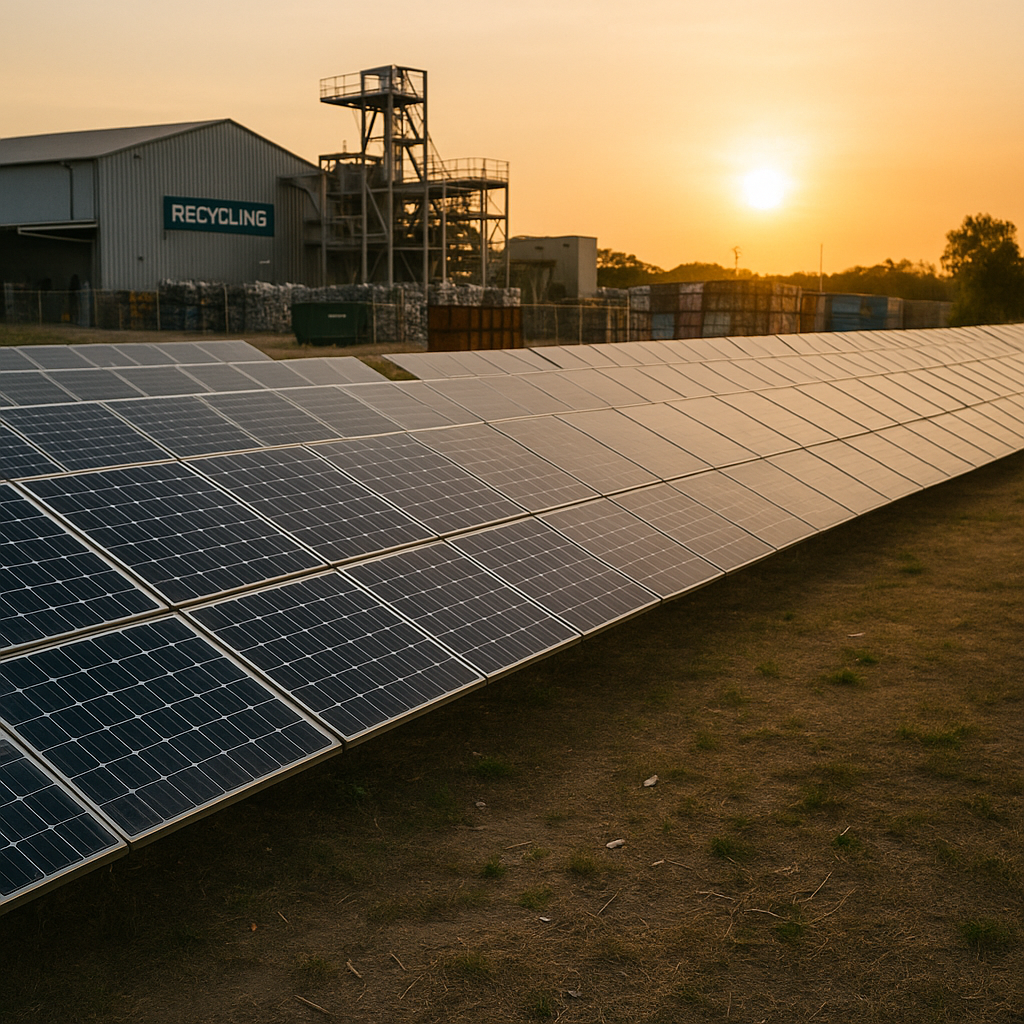5901 Botham Jean Blvd, Dallas, TX 75215
What is the Environmental Impact of Solar Panel Recycling?
May 14, 2025By 2050, the solar industry is expected to generate a remarkable 78 million tons of panel waste worldwide. This growing accumulation of discarded solar equipment presents both an environmental challenge and an economic opportunity. Solar panel recycling is at this crucial intersection.
Recycling solar panels tackles the environmental and economic issues related to end-of-life solar equipment. As global installed solar capacity continues its rapid growth—now exceeding 1,185 GW—many early installations will soon reach their 25-30 year lifespan. Without proper recycling, these panels could release hazardous materials like lead, cadmium, and other toxic substances into the soil and groundwater.
The environmental benefits of recycling solar panels are significant. Proper recycling can recover up to 95% of semiconductor materials and 90% of glass content. This process prevents approximately 1,200 pounds of carbon dioxide emissions per recycled ton compared to manufacturing panels from raw materials. Beyond reducing emissions, recycling helps conserve limited landfill space and prevents the leaching of toxic substances.
How Does Solar Panel Recycling Benefit the Environment?

Recycling solar panels provides significant environmental benefits by addressing key sustainability challenges. At the end of their 25-30 year lifespan, proper recycling prevents toxic materials from entering landfills and contaminating soil and groundwater. Materials such as lead, cadmium, and selenium in some panels can be hazardous if not managed correctly.
The resource conservation impact of recycling solar panels is considerable. It reduces the need for raw material mining, which often involves destructive extraction methods and habitat disruption. By recovering valuable materials like silver, copper, and crystalline silicon, recycling supports a circular economy approach to solar technology.
Recycling also significantly reduces emissions. Each recycled panel prevents approximately 97 pounds of CO2 emissions, and this figure increases to 1.5 tons if panels are reused rather than recycled. With millions of panels retiring by 2030, these savings will contribute to meaningful climate action.
Energy Conservation Through Material Recovery
Recycling solar panel components yields substantial energy savings. Recycling aluminum from solar panel frames uses 95% less energy than producing new aluminum from raw bauxite, avoiding the environmental impacts of mining, transporting, and refining new materials.
Glass recovery offers another significant benefit. Although currently sold for minimal value for basic products like bottles, recycled solar panel glass has the potential for higher-value applications, such as manufacturing new solar panels, further reducing the environmental footprint.
Silicon recovery also provides environmental advantages. While extracted silicon must be refined before reuse in new panels, recovering this material bypasses the energy-intensive mining and processing required for virgin silicon production.
| Disposal Method | Cost per Panel | Environmental Impact | Material Recovery |
|---|---|---|---|
| Landfilling | $1-$5 | High risk of soil and water contamination | None |
| Recycling | $20-$30 | Reduced CO2 emissions, conserves resources | Up to 95% of materials like silicon and glass |
Waste Reduction and Circular Economy Benefits
The potential waste from discarded solar panels is significant. According to the National Renewable Energy Laboratory, panels installed in the U.S. by 2021 that will retire by 2030 could cover about 3,000 American football fields. Without recycling, this material would occupy valuable landfill space.
Solar panel recycling supports a functioning circular economy. The International Renewable Energy Agency estimates that by 2050, the recoverable value from solar panel materials could exceed $15 billion globally, creating economic incentives aligned with environmental protection.
The global recycling market reflects growing recognition of these benefits. Valued at £250 million in 2022, it is projected to reach £1.29 billion by 2028, highlighting both environmental awareness and economic opportunity in managing end-of-life solar panels.
Yale Environment 360 reports that recycling mitigates supply chain vulnerabilities by reducing dependence on imported materials from Southeast Asia, bringing additional environmental benefits by cutting transportation emissions and energy use.
What Are the Challenges in Solar Panel Recycling?
Solar panel recycling faces significant challenges. Despite the increasing global use of solar energy, the recycling rate remains below 10%. This is alarming given forecasts of 8 million metric tons of photovoltaic waste by 2030, potentially reaching 78 million metric tons by 2050.
Economic factors are a major barrier to effective recycling. Recycling a single solar panel costs between $20-$30, while landfill disposal is only $1-$5 per unit. This cost disparity explains why most decommissioned panels end up in landfills instead of recycling facilities.
Material Recovery Challenges
The complex structure of solar panels makes material separation difficult and costly. Modern panels consist of multiple layered components, including glass (75% of weight), aluminum frames (10%), polymer layers (10%), and silicon cells with precious metals (5%).
Extracting valuable materials presents technical challenges. Removing the ethylene-vinyl acetate adhesive requires temperatures above 400°C. Silver extraction, though less than 1% of panel mass but 47% of reclaimed material value, demands sophisticated processes using potentially hazardous chemicals.
Can we develop more efficient processes to recover these materials without creating additional environmental problems? Researchers are working on solutions. Projects like Photorama aim to recover more than 98% of panel materials with 98% purity for reuse in new panel production.
Infrastructure and Logistics Limitations
Most regions lack adequate recycling facilities. The Solar Energy Industries Association reports only five companies in the U.S. provide complete recycling services. This shortage forces long-distance transportation of panels, increasing costs and carbon emissions.
Storage presents another challenge. Decommissioned panels require weather protection and proper handling, especially when damaged. Panels must be shielded from physical impacts, temperature fluctuations, and moisture to prevent hazardous material leakage.
Transportation safety adds complexity. Panels need precise packaging with foam padding, moisture barriers, and secure strapping. Loading procedures require specific equipment with minimum fork lengths and lifting capacities to prevent damage.
Regulatory Uncertainties
Inconsistent regulations across states create confusion for panel owners and recyclers. While Washington leads with manufacturer take-back requirements, most states have limited or no specific solar panel disposal regulations.
Hazardous waste classification further complicates matters. The EPA’s Toxicity Characteristic Leaching Procedure determines if panels contain regulated levels of lead, hexavalent chromium, cadmium, arsenic, or selenium, requiring specific handling procedures.
What impact would standardized national regulations have on improving recycling rates? Current regulatory frameworks often fail to address the unique challenges of solar panel disposal, leaving gaps in responsibility and oversight.
Small-Scale Recycling Obstacles
Individual homeowners and small businesses face unique challenges. Most recycling facilities are designed for utility-scale operations, processing thousands of panels daily with minimum waste volumes of 4,000 tons yearly to maintain profitability.
Small-quantity recycling operations deal with substantially higher per-unit costs. Processing facilities often charge premium rates for sub-optimal quantities, while transportation expenses rise sharply for small loads. Many recycling companies simply turn down small-quantity processing requests.
Some regional collection programs offer potential solutions by combining panels from multiple sources to achieve minimum processing volumes. These initiatives share transportation costs and reduce individual handling expenses, but remain limited in availability.
What is the Future of Solar Panel Recycling?

The solar panel recycling market is poised for significant growth, with projections estimating the global market will reach £1.29 billion by 2028. The industry is expanding at a compound annual growth rate (CAGR) of 7.4% from 2025 to 2030. This growth is driven by increasing solar installations worldwide and the resulting rise in end-of-life panels needing proper management.
Technological innovations are transforming recycling processes. Advanced separation techniques now achieve up to 98% recovery rates for critical materials. Thermal decomposition processes recover 95% of glass and 85% of silicon from panels. Robotic systems with artificial intelligence can identify different panel types and dismantle components while preserving valuable materials.
Chemical processing methods have evolved significantly. New electrochemical processes now extract high-purity silicon and silver more efficiently than conventional methods. Ultrasonic delamination separates glass without damaging components. These advancements make recycling more economically viable while reducing environmental impact.
The job creation potential is substantial. The solar recycling sector creates positions in collection, transportation, disassembly, material processing, and research roles. Large recycling facilities offer significant employment opportunities. For example, a single 5 GW recycling facility can process up to 10 million panels annually, requiring numerous skilled technicians and logistical experts.
By 2050, the circular economy benefits could be immense. Experts predict recovered materials could provide components for 2 billion new panels without raw material mining, representing approximately £11 billion in recoverable value. The environmental impact is equally significant, with each recycled panel preventing about 97 pounds of CO2 emissions compared to manufacturing new ones.
The industry is attracting significant investment. Venture capital firms and environmental funds are financing the development of efficient recycling technologies and regional processing centers. This financial support accelerates innovation and infrastructure development across the recycling ecosystem.
Regional growth patterns show Europe leading the global market with nearly 40% market share due to stringent environmental regulations. However, the Asia Pacific region demonstrates the fastest growth as China, Japan, and India see huge increases in solar installations and subsequent recycling needs.
Material recovery economics continue to improve. Silver content plays a crucial role in profitability. Panels with silver concentrations above 0.1% can be recycled sustainably without additional fees. Processing facilities handling over 18,000 tons yearly remain profitable even with lower silver content.
Recovered materials from solar panels have diverse applications across industries. Reclaimed silicon serves in new solar cells or electronics. Recovered glass becomes raw material for various glass products. The extracted metals enter manufacturing streams for multiple industrial applications.
| Year | Projected Value |
| 2050 | $15 billion |
This shift to comprehensive recycling completes the renewable energy sustainability cycle. As technologies advance and market needs rise, solar panel recycling will play a vital role in the sustainable expansion of solar energy. The industry transforms what was once considered waste into valuable resources, creating a truly circular renewable energy economy.
Conclusion: The Path Forward for Sustainable Solar Energy

Solar panel recycling is essential for achieving truly sustainable renewable energy. By recovering valuable materials like silicon, glass, and metals from end-of-life panels, the solar industry completes the circular economy loop. This process not only diverts waste from landfills but also reduces the need for extracting new materials. The environmental benefits extend beyond waste reduction, reinforcing the solar sector’s reputation as a sustainable energy solution.
As the solar industry rapidly grows, developing robust recycling infrastructure becomes increasingly critical. With millions of panels nearing their 25-30 year lifespan in the coming decades, establishing efficient collection systems and processing facilities will be crucial for solar energy to reach its green potential. By integrating recycling into solar development, we can create a renewable energy landscape that is sustainable throughout its entire lifecycle. For professional guidance on recycling solar panels and other electronic materials, contact Okon Recycling at 214-717-4083.
